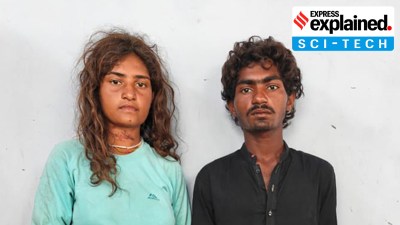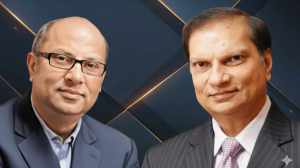SRK@60: How Shah Rukh Khan’s songs taught India to fall in love
From mustard fields to city skylines, how Shah Rukh Khan became the song on screen, defining love and longing for an entire generation.
 Shah Rukh Khan on a moving train winding through the Nilgiris in Chaiyya Chaiyya.
Shah Rukh Khan on a moving train winding through the Nilgiris in Chaiyya Chaiyya.In filmmaker Yash Chopra’s Veer-Zaara (2004), the now-familiar Do pal ruka khwabon ka kaarvaan arrived with the syntax and sensibility of a bygone era. Composer Madan Mohan’s melody, discovered and used posthumously in Lata Mangeshkar and Sonu Nigam’s voices, was built on pauses, a poignant string section, and a gnawing ache as two star-crossed lovers separated.
Shot at a train station, imagined as Attari, it wasn’t as immediate as many love songs were in Hindi films post the ’90s. Ones that didn’t hide behind a metaphor, and instead looked love square in the eye — ones that a shaggy-haired and charming Shah Rukh Khan had already been very convincing at. That raised eyebrow (Ek din aap yun humko, Yes Boss), the dimpled, impish half-smile between longing and surrender (Meri mehbooba, Pardes), the jumping jack sequences (Ruk ja o dil deewane, DDLJ), even romancing the heroine on horseback in an absurd black cape and eye mask (Baazigar o Baazigar) — one believed it all because it felt that he believed in it with a rare conviction.
And yet when one sees Khan as an Indian Air Force officer leaving Pakistani Zaara behind for her to be with the man she’s engaged to, he fits into the age-old and quiet dignity of the song’s heartbreak with as much ease. As if he were the actor the song imagined once. With the pale quiver of a smile, and restraint in tow, that ache quickly becomes a collective feeling — the story of heartbreak that belongs to all of us in some way, regardless of caste, class, religion or ideology. And that cannot be scripted.
The vulnerability of pain is hard to enter, but it’s that of joy that can be even harder to create on screen. Not the Aana mere pyar ko (Kabhi Haan Kabhi Na) kind, where Khan could walk up and down many cars with such effortlessness or break into a cartwheel like it’s second nature (Aisi deewangi, Deewana). This is a kind of joy that is unnervingly disarming. One just needs to watch Mehndi laga ke in DDLJ to see how he captures a certain tenderness of being in love with someone else’s bride. Or observe the surety and surrender of Tujhe dekha toh ye jaana sanam. All of this is what, perhaps, makes a flawed Raj such a lasting character. Something that’s allowed that ‘romantic image’ to endure longer than one can remember.
In fact, one of his greatest cultural interventions has got to be this vulnerability. On most days, his is the unapologetic romantic hero who sings and dances with passion, weeps without shame and is yet masculine. So the quintessential romantic superstar is not the guy who derives his strength from silent suffering and being emotionally guarded. And therein lies the subversion.
Three years later, as journalist Amarkanth Varma in Mani Ratnam’s Dil Se, he danced atop a moving train winding through the Nilgiris in Chhaiya Chhaiya — without safety harnesses, yet with complete surrender to the moment and to the meaning of Gulzar’s lyrics. The unwavering faith he brings to a character in the song is striking. No wonder it remains one of his finest outings.
As it happens, Khan’s songs, for years, have embodied the space where he is the most believable. Much more than in his acting, which has had its highs and some absolute lows. But it is in these musical capsules that Khan is almost always the most unguarded on screen. And therein lies our connection. He manages to find it when in a desert with Satrangi re, in water with Suraj hua maddham and especially in the emotional integrity of Javed Akhtar’s Kal ho na ho.
One would struggle to find a song where Khan is terrible. It will be easy to name films, though. Even in Apun bola (Josh) and Chammak Challo (Ra One), which are some of the most irksome songs in Khan’s arsenal, he does well to be convinced by his character and be in it on screen. Dard-e-disco is another story, though. No one seems convinced of anything there. Khan is known for making others feel loved. Dard-e-disco’s vanity turns him into a strange caricature.
What’s also interesting is Khan’s remarkable shift of gears with the voices that have sung for him and how he’s adapted to the emotional rhythm and personality of a tone. Playback singers were often associated with certain actors. Mukesh was Raj Kapoor’s voice, Mohammad Rafi for Shammi Kapoor, while Kishore Kumar complemented Amitabh Bachchan’s baritone. Khan carried the wistfulness of Kumar Sanu (Tujhe dekha, Do dil), the huskiness of Vinod Rathod (Aisi deewangi), the abandonment of Sukhwinder Singh (Chaiyya Chaiyya), the brightness of Udit Narayan (Jaadu teri nazar) Sonu Nigam’s contemplative grace (Kal ho na ho, Main hoon na), Abhijeet’s energy (Tumhe jo maine dekha), AR Rahman’s rawness (Dil se re), Arijit Singh’s emotiveness (Gerua, Chaleya), and even composer Anu Kapoor’s oddly theatrical voice that can’t be imagined to suit anyone. But Ye kaali kaali aankhen works seamlessly. That’s a testament to his exceptional adaptability.
Also Read | SRK@60: Why Shah Rukh Khan is Bollywood’s last, and only, superstar
As the world changes, for a generation, to fall in love will always mean remembering a Shah Rukh Khan song: the kind of love Khan so generously opens his arms to. The kind of love that’s inseparable from him and the ditties he inhabits, and definitely inseparable from what he means to the nation.


- 01
- 02
- 03
- 04
- 05





























